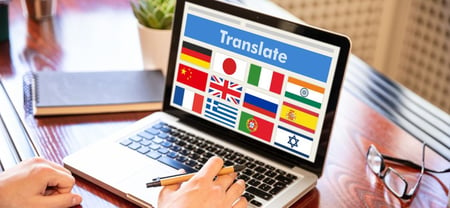From hiring superstar employees to supporting existing staff and helping them thrive, Human Resources (HR) is an indispensable resource and is likely to be one of your most important departments.
Human resource translations are crucial when you operate across multiple locations and languages, as misunderstandings or gaps in continuity can arise.
Ensuring your workforce can read and understand essential HR material will lead to happy staff and an office that runs like a well-oiled machine.
The complexity of HR material adds another layer to translation (beyond localization and transcription).
Take your employee policies or procedural documents, for example. These are likely to be full of important, detailed information that must adhere to certain guidelines or industry standards. If your translator is not aware of these, then you could find that your staff doesn’t have an equal understanding of policies and practices.
It may sound obvious, and of course, we say this as a Language Service Provider (LSP) ourselves, but we will always recommend going with a professional when it comes to translating your HR material.
After all, our professional translators have specific HR sector knowledge and experience.
To better explain why, our team has put together this list of common HR translation requirements, detailing the key things to plan for and be aware of during the entire process.
Most Common HR Translation Requirements
1. Ensure Your Translator is a Sector Expert
Ensuring sector expertise cannot be underestimated, hence why it’s the first one we’ve listed.
If you’ve chosen an LSP with HR sector expertise - such as ourselves - you can relax and feel confident that your translations will be both high-quality, nuanced, and tick all the industry legalities and requirements.
A translator who’s a subject matter expert will understand the meaning and context behind your material. They won’t just create word-for-word translations but will apply cultural nuances and regional differences.
However, if you’re completing your translations in-house, we’d recommend choosing somebody who has a comprehensive understanding of the HR sector over language knowledge.
It may sound counterintuitive, but getting the technical details correct should be your main priority.
Any errors or misunderstandings in your material could lead to headaches for your business further down the line.
2. Cover All Guidelines, Legalities, and Requirements
The HR sector is chock full of standardizations and strict guidelines, with good reasons, of course. They exist to protect both your employees and the business itself.
However, these can change from location to location, so any translator you’re working with should be coherent and confident in all necessary regional requirements.
It’s particularly important to pay attention to sensitive material, such as exit policies or compensation and benefits overviews.
Should an employee leave or be terminated by the company, you want to remove any room for misunderstanding from the official documents.
The same goes if you want to discuss salary or stock options, for example. Leave no space for error or confusion. Clarity is key.
3. Understand the Purpose of the Documents
Whether clarifying company policies, onboarding new starters, or improving employee development, every one of your HR documents will have a unique objective. It’s important that your translator is aware and mindful of them.
By putting the document’s purpose front and center, you’ll get a more detailed and higher-quality translation.
This will, in turn, help to keep everyone on the same page and working towards the same business goals, no matter if the team is located in Rio de Janeiro, Paris, or Tokyo.
While you’re thinking about all things HR and achieving objectives, your eLearning and training materials should also be presented in your employees’ native languages.
When your staff has the opportunity to learn and train in their own language, it can work wonders for their personal development, which in turn can increase employee retention.
4. Ensure a High-Quality Output
Of course high-quality translations are necessary, it’s a given. But we’ve included this point to really emphasize their importance. Any translation slip, slight errors, or ambiguity could be detrimental to the clarity and understanding of your documents.
To be sure quality is at the forefront of your translation, get prepared with translation glossaries, style guides, and brand manuals so your translator is clear on who you are and how you talk as a business.
Then, be sure sentences are clear, concise, and leave no room for misinterpretation. This will keep things accurate and help you and your team check for any errors.
Finally, be sure you have several rounds of proofreading ready by way of quality control.
Get a Quote for Your HR Translation
Translating HR documents is very important for keeping a happy and informed workforce, especially when your business works in many languages. If HR documents are not clear, it can cause confusion and disrupt how your office runs. Making sure that every employee understands your company's rules and policies is key to a smooth workplace.
Schedule a free consultation with us at LinguaLinx to talk about your HR document translation needs. Our team has specialized HR knowledge and 20 years of professional translation experience. We focus on getting every detail right, including cultural differences that are important in HR materials.
With LinguaLinx, you can trust the quality of your translations. We have ISO 17100 and ISO 9001 certifications, which show we stick to the highest standards in our translation work. These certifications make sure that we always meet our clients' needs for technical accuracy and quality.
Contact us today to find out how we can help you translate your HR materials effectively, keeping your global team on the same page. Choosing LinguaLinx means choosing a partner who focuses on clear and precise translations for every project.







